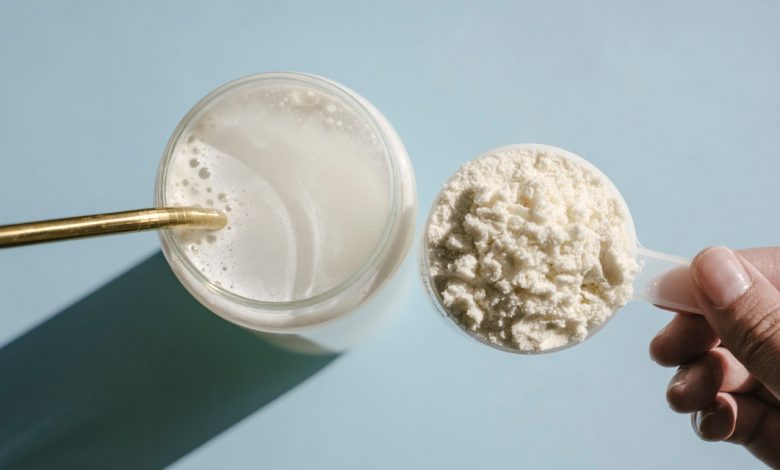How to Make a Protein Shake to Jumpstart Your Recovery

If you’ve ever wondered how to make a protein shake, you might think the back of your tub has the answer for you: Simply scoop out some protein powder, add water, give the mixture a good shake, and there you have it.
This isn’t not true, but it’s also not the whole story, either. If you find an option you love—say, a whey protein if you’re okay with milk products, or dairy-free options like hemp seed or pea protein if you prefer plant-based protein sources—you absolutely can make a shake out of just a scoop or two and some liquid. But if you’re willing to expend a little extra time and energy, you can use whole foods to craft a high-protein drink that’s perfectly suited to your palate and your nutritional goals.
Regardless of which kind you pick, all these shakes have one thing in common: They deliver a hefty dose of protein. And that’s important, since after you work out, your body is primed to absorb nutrients, Amy Stephens, MS, RDN, a registered dietitian and certified specialist in sports nutrition, tells SELF. In the case of protein (especially in conjunction with carbs), this helps with both muscle recovery and muscle hypertrophy (or growth). A protein shake, Stephens adds, is “an easy, convenient way to obtain those nutrients without having to make food.”
So just how much of its namesake ingredient should a protein shake contain? It depends on a couple factors, including whether you’re downing one as a post-workout snack or a meal substitute, Jason Machowsky, MS, RD, a sports dietitian and registered clinical exercise physiologist, tells SELF. If it’s the former, shoot for anywhere from 25 to 35 grams of protein, he says. In the case of the latter, 10 to 20 grams should do it, Stephens says.
If you’re making your own shake, protein content isn’t the only thing you need to worry about, either—you have to consider taste and texture as well. To learn more about how the pros pull it off, we asked Machowsky and Stephens to walk us through the process of crafting a shake from start to finish.
1. Choose your base.
Depending on the consistency you’d like, you could go with a full-on liquid or something a little heftier, like yogurt or cottage cheese. Either way, you’ve got tons of options, from actual dairy to plant-based alternatives.
But if you really want to optimize protein content with your base, a yogurt or a dairy milk will likely be your best bet—these can easily reach that 10- to 20-gram baseline, Stephens says. For instance:
- Plain, whole-milk Greek yogurt: 22 grams of protein per cup
- Ultrafiltered whole milk: 13 grams of protein per cup
- 2% or whole milk: 8 grams of protein per cup
What’s more, dairy milk is considered a complete protein, meaning it contains all nine of the essential amino acids, and packs other important nutrients like calcium, too. (Some plant-based milks may be fortified with calcium and vitamins to make them more nutritious, but the calcium in dairy milk is generally more easily absorbed.)
But there are plenty of other options out there if dairy’s not your thing—say, if you have lactose intolerance or food allergies that can trigger gas, bloating, and diarrhea after a glass of the real stuff, or hell, just don’t like the taste. In these cases, “I think non-dairy milks are great,” Stephens says. Specifically, she recommends soy milk, which has the most similar nutrient profile to dairy of all plant-based alternatives, according to the FDA. You can also try coconut water. Even though it won’t contribute much in the way of protein, Stephens says, it packs a ton of potassium—a nutrient that plays a role in tons of critical body functions, like heartbeat regulation and muscle and nerve activity. So if you’re adding some other protein-rich stuff to your shake (see below), that can be a solid option.
If you’re going the plant-based route, here’s how the protein content shakes out (sorry!) for some popular kinds:
- Unsweetened soy milk: 9 grams of protein per cup
- Cashew milk: 5 grams of protein per cup
- Unsweetened almond milk: 1 gram of protein per cup
- Unsweetened coconut water: 0.5 grams of protein per cup
- Coconut milk: 0.5 grams of protein per cup
Because these do tend to be lower in protein than the dairy bases, Stephens recommends adding in a scoop or two of your favorite protein powder to provide an overall boost. Here are some solid (and tasty, we promise) tubs to try.
2. Mix in the fun stuff.
Once you’ve settled on a base, it’s time to customize your shake by adding a few of your favorite things, from produce like apple slices to pantry staples like Nutella.
These add-ins also play another vital role besides appealing to your tastebuds. For the most efficient post-workout recovery, you want “a three-to-one ratio of carbs to protein,” Machowsky says. So if your shake contains 10 to 20 grams of protein, say, it should also contain 30 to 60 grams of carbohydrates. That’s because this macronutrient helps replenish your body’s depleted energy stores. (Of course, you can also pair your protein shake with carb-rich sides like a bowl of granola or a slice of whole-wheat toast to achieve that important ratio, but if you can get it all done in one glass, well, you’ve made your life so much easier!)
With that guidance in mind, here’s a few popular add-in options:
- Yogurt: Yep, even if you went with a different base, this can still be a great mix-in. Simply spoon in a dollop for some extra whole-food protein (and creaminess) if you’re still a few grams away from your goal, according to Machowsky.
- Flax seeds and chia seeds: Rich in fiber—a type of carb—and healthy fats, these prebiotic powerhouses “can be a great way to really maximize the nutrition in a small amount of food,” Stephens says. Each cup provides between 28 and 30 grams of protein.
- Fruit: Think dates, bananas, apples, mixed berries, or even vitamin C-rich citrus options like oranges—basically, whatever you like the best. Fruit is an amazing source of flavor (and carbs), according to Machowsky. Dates in particular, he adds, are a “natural sweetener.” Pro tip: Using frozen fruit will lend your shake a thicker consistency. Frozen bananas are especially good for this.
- Veggies: Spinach and kale are popular options. “If you don’t love the taste of [either of] those, putting it in a smoothie with a lot of other ingredients can dilute the flavor,” Stephens says. Yep, a protein shake can double as a covert delivery service for your daily serving of greens.
- Nut butters: Peanut butter or almond butter pretty much never disappoint here. Like the nuts they’re derived from, they’re considered a reliable source of protein (packing a decent amount, at about 3 grams per tablespoon) and healthy fats, according to the American Heart Association.
- Oats: These carb- and antioxidant-rich grains make an excellent thickener, according to Machowsky. One cup contains 11 grams of protein.
Okay, yes, there are a lot of options there. Need a little guidance? We’ve made it easy with a list of 10 homemade protein shake recipes that make use of all this good stuff.
3. Add some finishing touches.
Not 100% satisfied with the final product? Play around with your ingredient quantities—and if you still feel like something’s missing, you can always try introducing some new textures or flavors to improve your blend.
To elevate the sweetness, Machowsky suggests adding in honey or vanilla extract. (Maple syrup can work similarly, too.) If you’re looking “for a chocolate component,” try cocoa powder or even chocolate protein powder. (Vanilla protein powder is an option if you’re more into that direction). You can even mine your spice rack for ideas: Cinnamon or some other sweet seasoning could pair beautifully with chocolate or vanilla. If consistency is more your concern, try instilling some bulk via instant oats—or something more exotic. “I’ve known some to thicken it up with things like avocado,” Machowsky adds. Finally, consider dropping in a few ice cubes for some extra chill.
4. Enjoy your recovery.
There you have it: exactly how to make a protein shake. With all the fine-tuning out of the way, your beverage is ready to serve: frothy, creamy, and perfectly tailored to your tastes. Not only will the protein content promote muscle repair, recovery, and growth (and the carbs, energy replenishment), the liquid will also have a much-needed hydrating effect. You “are sweating out a lot of fluid from your body when you’re training hard, especially in a hot or humid environment,” Machowsky says. “So getting that fluid back into your body, back into the cells, is important for overall recovery and thermal regulation.”
One word of advice, though, before you get chugging: Nutritious as protein shakes are, they shouldn’t routinely replace breakfast, lunch, or dinner. So by all means, sip away—but make sure you take the time to sit down for a square meal at some point, too.
Related:
- 15 Easy Ways to Add Extra Protein to Your Day
- The Super Easy Way to Add a Bunch of Protein to Any Cereal
- 14 Protein Bars That Actually Taste Good
Get more of SELF’s great wellness advice delivered right to your inbox—for free.



